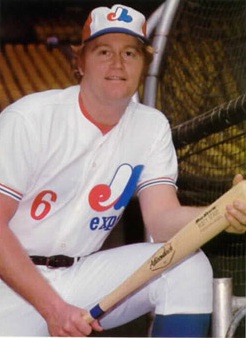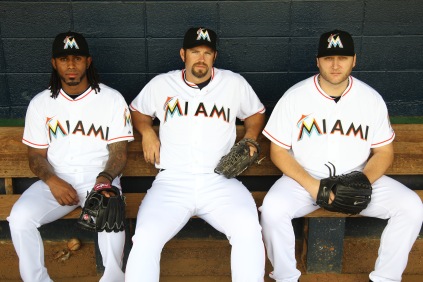Jeffrey Loria is a sleaze.
Loria, owner of Major League Baseball’s Miami Marlins, recently dismantled his team by trading its five best – and most expensive – players to Toronto for a handful of cheaper prospects, the balance sheet trumping the scorecard with unabashed clarity. Worse still, the demolition – which actually began in July when disgruntled All-Star third baseman Hanley Ramirez was shipped off to the Los Angeles Dodgers – comes less than a year after Miami’s brand new stadium, Marlins Park, was christened.
The ballpark, a $515 million dollar state-of-the-art athletic palace – complete with aquariums behind home plate and an immense retractable roof, was supposed to usher in a new era of style and success to South Florida. Instead, thanks to Loria, it is now home to little more than the echoes of broken promises and a hollowed out player roster. Rather than a sparkling home for a dynamic team on the rise, Marlins Park is more like a ghost ship, an eerie shell of what was supposed to be.
And the sadistic punch line? Miami taxpayers are on the hook for $300 million of the stadium’s gaudy price tag while Loria laughs all the way to the bank. According to Forbes Magazine, the franchise is now worth $450 million, which includes a 25% equity increase the moment the ribbon was cut on the new stadium. And without the pesky impact of a high payroll on operating expenses, the bottom line for Miami’s penurious owner looks rosier and rosier – the wreckage of a livid and heartbroken fan base notwithstanding.
Despite calls for Major League Baseball to intervene, there’s little chance of mediation of any consequence, because Loria has done this before without so much as a strongly worded reprimand as punishment. In fact, the last time he eviscerated a big league franchise Baseball Commissioner Bud Selig saw fit to not only give Loria an escape from the team he destroyed but also approved a loan for him to purchase a new club.
Selig, it should be noted, was a former owner of the Milwaukee Brewers before assuming the role of acting commissioner in 1992 – a position designed to be the impartial arbiter between labor and management. So, as Selig brimmed with conflict of interest, it was of little surprise that he dealt Loria the most favorable hand possible after the latter wrecked his first team and will likely do nothing after Loria decimated his second team.
And that first team, the Montreal Expos, was utterly and irrevocably wrecked – with Loria manning the bulldozer that leveled every last trace of them.
The Expos had been in Montreal since 1969 and had built an uneven but colorful history in Quebec. Outfielder Rusty Staub, affectionately nicknamed “Le Grand Orange” for his bright carroty hair, was the team’s first star.
Future Hall of Famers Andre Dawson and Gary Carter headlined contending ball clubs in the 1980’s, which also featured speedy outfield star Tim Raines and pitching stalwart Steve Rogers.
In 1994, the Expos had the best record in baseball with Canadian-born slugger Larry Walker leading the way. Unfortunately, a players’ strike interrupted the season and dragged on long enough to force the cancellation of the entire post season. So, the year Montreal was most suited to win a championship there was no championship to be won.
Behind the scenes, Loria had parlayed his initial $30 million investment in the franchise into a managing partner role with the team in 1999. As a sign of things to come, he failed to secure English television and radio deals for the 2000 season, meaning the only way fans could follow the Expos when they played on the road was to listen to French radio broadcasts. The unprecedented media invisibility hinged largely on Loria’s insistence on uncompetitive fees for the broadcast rights.
Even then, it was clear that he was in it for the money and couldn’t care less about much else.
However, professional sports teams have a symbiotic relationship with the cities in which they play. These teams necessarily become part of the cultural fabric of the area. While they provide excitement, jobs, and fractional identity to cities, they also need support and revenue from residents in return. And the tacit agreement that holds it all together is that the team willingly fields an entertaining and, hopefully, winning product.
When profit supersedes that equation, though, the relationship with the public can deteriorate quickly. In Montreal, Loria’s disdain for anything that would curtail his personal stake in the club doomed the team.
On the heels of the radio/TV debacle, Loria also demanded a publicly financed new ballpark – largely to increase the equity of the franchise – for a team that lost at least 90 games for three straight seasons. And the city of Montreal was in economic hardship already and simply did not have the ethical indifference to prioritize a baseball stadium over schools and hospitals.
So, Loria turned to Major League Baseball to bail him out.
Had Bud Selig a less gelatinous spine, he might have made sure Jeffrey Loria stayed at least 250 yards from a Major League Baseball franchise for the rest of his days. Instead, Selig took the unprecedented step of having the rest of the league purchase and own the Expos in 2002, run them despite competing against them for two full seasons, and shuttled them off to Puerto Rico for 22 “home” games as a way to “internationalize” the sport (and garner a tidy sum for holding such games abroad).
The Expos staggered through the 2004 season before being sold to Ted Lerner and moved to Washington, D.C., leaving a trail of betrayed fans in Quebec – a funny way to promote internationalization of the game, indeed.
As for Loria, Selig not only absolved him from the mess in Quebec he arranged for a $38,5 million loan, enabling Loria to become the majority stake holder in the then-Florida Marlins. The inmate had not only run one asylum and left it in ruins he had been given money to escape the wreckage and run another one.
Just as he had in Montreal, Loria again pushed for a publicly financed stadium for his new team. However, this time, he got it.
In an apparent sign of good faith, Loria spent the 2011 off season signing some of the biggest free agents in the game as a much ballyhooed run up to the grand opening of the new ballpark.
Shortstop Jose Reyes signed a six-year, $106 million deal. Three days later, veteran left-handed pitcher Mark Buehrle signed a four-year, $58 million contract. Closer Heath Bell was also added to the roster for three years and $27 million. In less than a week, the Marlins added three marquee players and $191 million to their payroll. Flamboyant manager Ozzie Guillen, whose fiery antics were the stuff of reporter’s dreams but had also gotten him run out of Chicago, was brought in to lead the team – and the publicity machine.
It seemed like Loria finally understood the responsibility of a franchise to its community. But like much else in his baseball life, he hadn’t the stomach for much of anything other than his own interests. When the team got off to a slow start and struggled to climb in the standings, he began to disassemble his expensive creation.
Starting pitcher Anibal Sanchez and third baseman Ramirez were jettisoned at the trade deadline in July. After a miserable last place finish, Guillen was fired and Bell was traded to Arizona. In the coup de grace, Reyes, Buehrle, star pitcher Josh Johnson, catcher John Buck, and outfielder Emilio Bonfacio were sent to Toronto.
In the end, Loria’s good faith with the city of Miami had lasted all of ten months.
As for what lies ahead for the Marlins, perhaps outfielder Giancarlo Stanton – the team’s lone remaining standout – put it best. After the Toronto trade was announced, Stanton, a 23-year-old slugger who hit 37 homers in 2012, tweeted, “Alright, I’m pissed off!!! Plain & Simple.”
A lot of fans in Miami echo the thought, and many more in Montreal sympathize.
Not that any of it makes a difference to Jeffrey Loria. He’s a sleaze – Plain & Simple. It’s just too bad he has a friend in such a high place in the game.
Sources:
http://www.washingtonpost.com/wp-dyn/articles/A10599-2004Jun27.html
Photos:
http://nesncom.files.wordpress.com/2012/11/jeffrey-loria.jpg?w=400&h=225
http://25.media.tumblr.com/tumblr_m35zaomJjf1qd07i8o1_500.jpg
http://www.baseballcardpedia.com/images/Expos-PCs-1979-Rusty-Staub.jpg
http://24.media.tumblr.com/tumblr_ly9i5xsjxE1qm9rypo1_1280.jpg
http://postmediacanadadotcom.files.wordpress.com/2012/11/111412exposfan.jpg?w=660&h=330&crop=1
http://blog.timesunion.com/sportsmedia/files/2012/02/Marlins.jpg
http://www.philliedelphia.com/.a/6a01348829760c970c017ee513b957970d-500wi
http://www.sportsgrid.com/wp-content/uploads/2012/11/Selig-and-Loria.jpg











